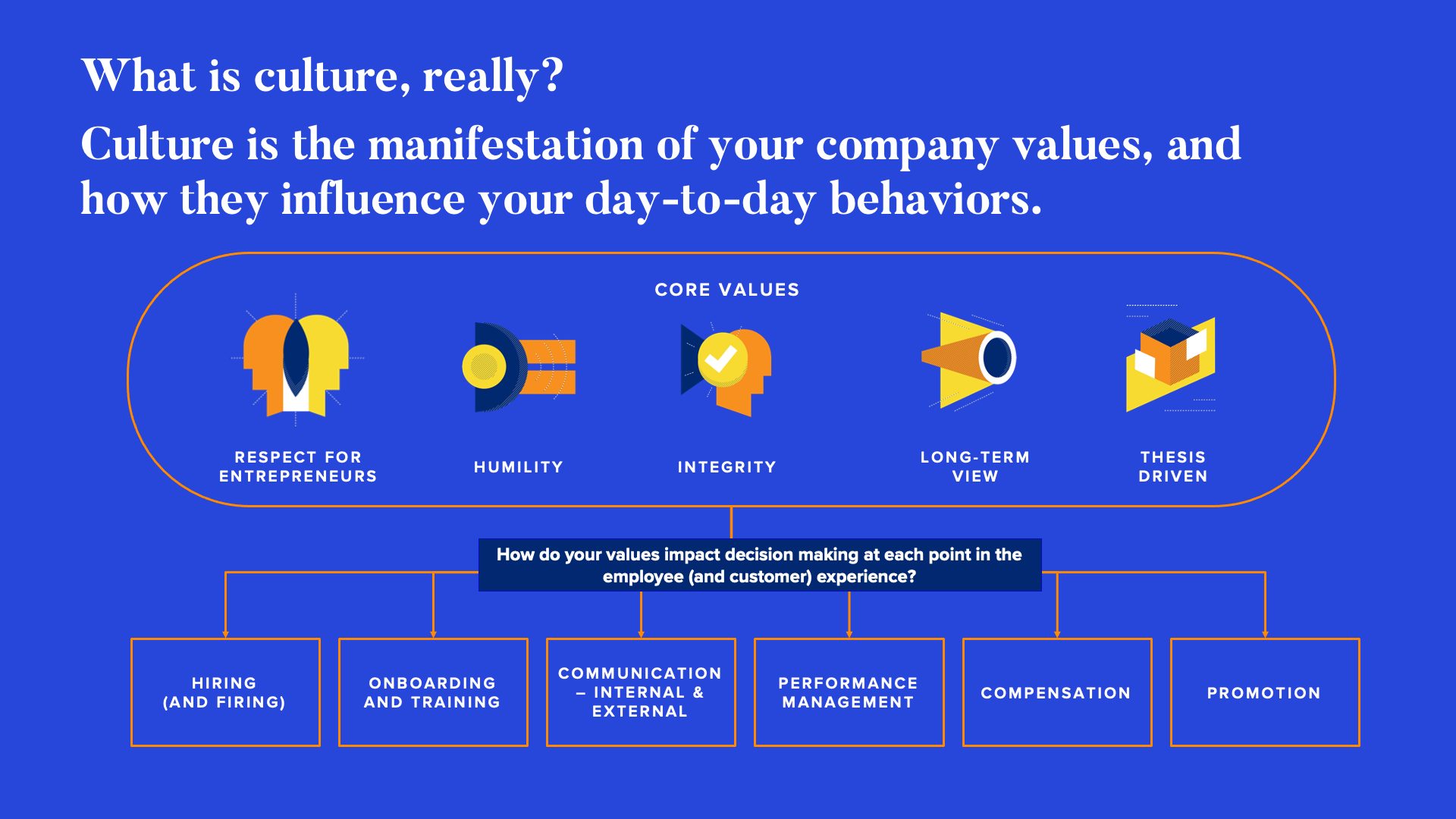
Helpful Tips and Mental Models for Strengthening Your Company Culture
I have heard many experienced CEOs say that core values and culture are the first things they think about when starting a new business. Having worked at a few startups and seen cultural strengths and weaknesses, this comes as no surprise. Strong culture is the bedrock of a successful company, but it is one thing to set the foundation for culture, and quite another to maintain it as you rapidly scale your business.
Scaling culture is a particularly hot button issue for startup leaders in 2020, as many deal with high growth in a fully remote setting for the first time. To dig deep into this issue, we recently brought together a panel of CEOs from the Georgian CoLab to share their lessons learned on building a lasting company culture. It was an inspiring discussion with leaders that I really admire, so I wanted to share a summary of the quotes and mental models that stuck out to me.
If you have ever had a hard time nailing down a clear definition of what culture truly is, here is the mental model I sketched out as I was listening to the panel:

I came away with a clear impression that the best cultures come from careful consideration of core values and deliberately operationalizing those values in day-to-day actions.
Below are some of my key takeaways and favourite quotes from the discussion – I hope you find them helpful!
Culture Develops from Operationalizing Values
Our first panelist was Hanif Joshaghani, co-founder and CEO of Symend, which combines behavioral science with advanced analytics in the field of debt recovery. Symend grew exponentially this year in an entirely remote setting, from 60 employees in March to nearly 250 employees today.
“I actually struggled with defining culture myself,” Hanif admitted. “Everybody’s definitions were different, and as we started to operationalize it within Symend, I needed to really get my own definition straight.”
“There’s a process. First, you define the company’s values, almost like the ten commandments governing what we care about, how we work and how we will not work.”
“To me though,” Hanif continued, “that is not the culture. Culture is when you go and operationalize those values in every single piece of the way you work. Everything from the way you recruit, promote, reward and recognize, to the things that guide the way you make strategic decisions, to who you will and will not work with. It starts to become more and more embedded into daily work. Culture develops as a result of sticking to your values.”
Communicating Values Starts in the Job Description
Our second panelist, Marie Chevrier Schwartz, founded Sampler in 2013. Sampler helps brands deliver product samples to a targeted audience, complete with measurement and consumer insights.
“About two years ago,” Marie explained, “we really stopped and thought… what is our culture at Sampler, and how do we want to grow it? The main question we asked ourselves was, ‘how do we show up to work?’ The team came up with five values defining Sampler: ownership, transparency, inclusivity, growth and balance. Lately, with COVID, balance is the one defining us the most.”
Marie shared that communicating Sampler’s core values of growth, ownership, and transparency starts in the job description. “We started writing what you can expect three months, six months, nine months and a year into the job. We have high expectations for growth, and I really want to ensure the way they are planning to grow in their careers is a really good match for how we want to grow. It also makes sure managers are clear about what this resource is going to achieve.”
“We want everyone to feel like, ‘I can be the next director. What do I need to do to get to that step?'”
Interviewing Consistency Helps Avoid Culture Fit Bias
Values-based interviews are a great tool to find hires that are a good fit for your culture.
“We’re still smaller—35 people right now—so we can still have 10-15% of the organization meet with the candidate, which is a huge luxury,” explained Marie. “We drafted questions and they’re usually more situation-based, like how would someone go about solving a problem. You can find values in the way the person describes the solution if it’s a well-worded question.”
“Don’t ask them how they collaborate,” Hanif agreed. “Ask them to give an example and look for signals. ‘Hey, walk me through a project where you did X, Y, and Z.’ In the way they describe these things, you can see whether they’re paying lip service or whether it’s real.”
Our final panelist was Zak Hemraj, co-founder and CEO of Loopio, a startup that streamlines RFP responses. Zak warned that companies need to be aware of their biases in the hiring process. “There is no silver bullet answer to biases,” Zak said. “It takes a lot of work, a lot of training, a lot of discussion. We’re still learning. Bringing in external help is extremely powerful for an organization, and every time we’ve done it, it’s been so valuable. It helps neutralize the discussion. There are so many things to eliminate or help reduce bias in the interview process, from making sure certain groups are represented to how you frame specific questions to even how you debrief. It’s important to start challenging each other internally and constantly evolve.”
Culture Should Evolve
The panel agreed that as new hires join, they bring new elements to your culture and it’s natural for your culture to evolve.
“I don’t think culture should be protected,” stated Zak. “Sometimes the best thing for culture is evolving, letting go of that thing that worked when you were 20 people and no longer works when you’re 50 or 100 people,” Zak continued. “It’s really about thinking about what’s best for now and for the future and holding your values at the center of it.”
This is where I feel my mental model above can be helpful to use as a template for a living, breathing document. As a leadership team, if you have a written guide for how your values influence decision making in each area of your business, you can revisit these over time and consciously decide how they should evolve depending on your stage.
“As a founder, you have to be okay with change,” Marie added. “If the teams that were there two, five years ago aren’t following, then maybe that’s a sign. That’s a really uncomfortable conversation to have, but I’ve definitely been in that situation and grew better from it.”
Onboarding Integrates New Hires into Company Culture
With so many new hires joining, the panel members all underlined the importance of onboarding programs.
“We have this comprehensive onboarding program now,” explained Hanif. “We’ve been batching people into cohorts every other week. There’s one session with the story of Symend, why we started, why it matters, where we’re headed. That’s still taught by me. That’s an opportunity for me to engage with them a little bit.”

However you set up your onboarding, consider whether it could be done differently in the virtual world.
“One problem I’m seeing right now,” Zak pointed out, “is that we’re just trying to simulate what we were doing in person and doing it virtually. That can be an uphill battle. What’s the most efficient path to get the result we want? If your goal is to make someone feel welcome, make sure they have all the information they need, then take a step back and ask, ‘Well, how can we do this in this new world?’ Our office operations manager now spends most of her time thinking about remote experience.”
Culture is a Product of Behaviors
Once your hires are up to speed, you can think about culture as a product of how each employee acts. Loopio has tried to build a “people-first, growth-oriented culture optimizing for alignment and impact.”
“Culture is the answer to a simple question: how do you behave?” Zak stated. “It’s a product of the behaviors you live and breathe every day, but sometimes, more importantly, the behaviors you don’t tolerate within your organization.”
“Double down on the culture of ownership,” advised Zak. “Our culture ties into business performance by driving unbelievable levels of team ownership. Be very clear about the mission that you have in the market, why it matters, why the team structure matters, why the values matter. Then you can tap into that sense of ownership.”
“You can enforce behaviors with carrots and sticks, but nothing drives better results than intrinsic motivation.”
Communicate the Value of Equity
One way to align motivation and incentivize your team to think as owners is through equity. When asked about communicating ownership and equity to employees Zak stated, “Ultimately, I don’t think most companies that grant stock options talk about them enough. It’s important to educate employees on when liquidity may happen and what it actually means.”
“So, from really early on in our journey, when we present the offer, we do a whiteboarding session to show what stock options mean, what an equity plan means. Every time the valuation of the company changes, you can do that education,” explained Zak.
“Symend is 20-25% owned by employees,” revealed Hanif. “So, everybody’s an owner. Every offer package shows exactly what ownership means and, depending on how we execute against the roadmap, what that equity is going to be worth in the next 12 to 18 months. We create milestones like, ‘hey, if we hit these four goals, then we’ll be at an X valuation’. Everybody gets a milestone bonus, and part of that is always equity.”
“People behave the way you comp them. That’s one of the first things one of my mentors taught me,” Hanif added. “You align their comp to the behavior you want and it’s going to move you massively toward that outcome. And so we’re very, very systematic about it. And we make sure that people are invested and excited about the company hitting its goals. “
Transparency Needs Balance
Finally the panel addressed the question of how to be transparent with their teams to share insights on decision making and business performance.
“Transparency is a big theme for us at Sampler” noted Marie. The company uses objectives and key results goal-setting tools (OKRs). “This makes sure goals start cascading down from the company vision the leadership team sets for the year, all the way into individual contributor objectives. That’s been really big, having everyone see how what they’re doing day-to-day is contributing to the larger goal. That’s one part of transparency I think we did really well.”
“Transparency is not an excuse to not be thoughtful,” Zak stated. “I think our number one job as leaders in a company, especially in a company that’s rapidly changing, is to provide context. So just opening the doors to everything like, ‘Okay, here’s our cash balance’ and not really helping someone interpret what that means, especially when they don’t have the exposure you have, is actually just going to be disruptive within an organization. I’ve seen this happen too many times. Every company needs to be intentional about what they’re sharing and why.”
“We try, as a guiding principle, not to make any decision that if it comes to light, you’d be having a hard time dealing with it,” Hanif added. “If you’re going to have a problem explaining something, chances are you shouldn’t be doing it.”
“We put together a small council, the Sampler Values Committee,” Marie shared. “The leadership team goes to them with big initiatives we are launching and confirms the language is right, it doesn’t raise questions, or if it raises questions, we address them first. It’s really incredibly helpful to have that.”
—
This panel took place as part of ScaleTech conference, sponsored by the Innovation Banking Group at the Bank of Montreal, which brought together CEOs and other startup industry leaders to discuss pressing questions facing entrepreneurs in the scaling stage. New this year was CoLab Day, exclusive to participants in Georgian’s pre-investment nurture program, the CoLab. These early-stage CoLab startups benefit from Georgian’s expertise, content and network, helping them grow and mature. Thanks to all of the participants for their insights and I can’t wait for the next CoLab event.
Read more like this
Cloud Spend Management: A Guide for Startups
Over the past several months, CoLab executives and customers have told us…
How to Use OKRs to Unlock Your Company’s Potential
You’re probably familiar with OKRs — Objectives and Key Results. OKRs are…
Team Profile: Azin Asgarian, Applied Research Scientist
What do you work on at Georgian? As part of the R&D…